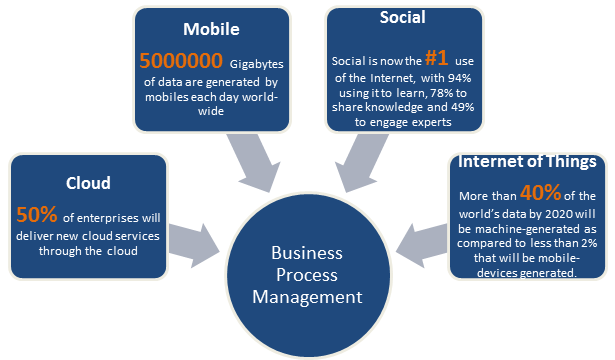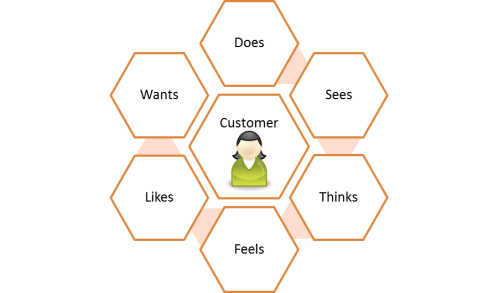Change is commonplace. However, the forces driving change in the marketplace have never been as disruptive as they are today. Businesses have to be nimble to adapt to and adopt these inevitable changes. This process of adaption and adoption calls for a shift in the Business Process Management (BPM) landscape as we know it. Convenience and engagement are now prioritized ahead of automation and standardization as the core values of BPM. This blog discusses the impact that the disruptive forces – mobile, cloud, social, big data, internet of things – are having on business processes and shifts that the business have to make to ensure there are no tremors.
Reality of Disruptive Forces
While we all know that change is inevitable, it is the speed of change that has taken some of the less-nimble businesses by surprise. Widely available broadband bandwidth has led to explosive changes. As the marketplace changes rapidly, business strategists realize that they need to constantly reinvent themselves to overcome these VUCA challenges. So, in light of these disruptive forces (see graphic below) – Are you prepared to navigate the dynamic and rapidly changing landscape of Business Process Management?

Cloud
With businesses steadily opening up to the cloud model, we are witnessing business processes move to the cloud – especially the ones that do not deal with sensitive data. Businesses are increasingly turning to dynamic hybrid cloud to reduce costs and enable more scalable and flexible business processes. This means that the new-age processes could involve process orchestration between an application(s) sitting on-premise and another application(s) hosted on the cloud. While the BPM process engine functionality should be able to drive that orchestration, this also means that businesses have to think beyond the “process optimization” principles that have been at the heart of process improvement approaches. This does not take away the significance of all that has been done till date for process improvements – it just requires businesses to think differently about ways to drive efficiencies. Most of the process improvement effort till date has been relatively ignorant of the hosting location of the business applications. However, this rewiring of businesses will make it necessary to start considering hosting options as well because they drive down costs substantially and deliver a much better end-user experience. Innovative thinking around this could lead to the evolution of new business models driven by business processes that are remarkably different from the ones we have known in the past. Consider this – till a couple of years back amazon.com would have meant ordering your favorite book, an electronic gadget online. The fact that they realized there is inherent potential in their huge IT infrastructure that can be tapped into – and came up with Amazon Web Services – leading to a new business model. This innovative thinking means that Amazon today has business processes around remote computing services that were non-existent a couple of years ago.
Mobile
With handhelds (mobiles, tablets, phablets) replacing the desktops and laptops as the preferred gadgets to stay online, they are driving businesses to think. Mobile enterprises can attract new customers, transform their business and IT infrastructure, develop mobile apps to boost enterprise efficiency, and improve customer service and interactions.
The new-age mobile enterprise is opening up to the concepts of BYOD (Bring Your Own Device) and COPE (Corporate Owned, Personally Enabled) to deliver an experience that is employer-friendly. With handhelds being commonplace in work environments, the business processes stand to benefit from them – if leveraged the right way. The fact that a customer’s loan could be approved by a credit manager on his ipad while he is waiting for the boarding announcement at the airport means that the end-to-end process execution times are ready to be redefined. In today’s business-in-motion environments, workers expect to be connected to their critical business processes while on-the-go. It is imperative to deliver more meaningful user engagements by extending business processes to the mobile working environments. However, one needs to note that handhelds are not just another device to access the same service – they are a different form factor and that means that they need to deliver an experience that is substantially different from the web-experience. Boilerplate solutions that are clones of the web applications will not work here. So, while defining business processes for the new mobile world and defining the user interfaces along the business process, one has to extend their horizon to think of delivering the “right” experience across form factors.
Social
Social networks have invaded our world and are becoming (if not already) an extension of ourselves. Social business has created a new source of human data, enabling businesses to gain greater insight into the sentiment, activities, performance and behaviors of large number of people. These businesses are driving enterprise-wide collaboration and workforce talent optimization by interweaving their social strategy with their overall business strategy. With an influx of millenials into the workforce, social networking is already pervasive and business processes have to wake up to this reality. The new-age workforce wants to use social networks to share content, have livid discussions on communities, share experiences and work cohesively – at scale and without boundaries.
Business Processes stand to gain from this shift. Consider this simple use case – we have seen many business processes that keep looping back and forth between process participants for want of some information/document resulting in a longer execution cycle. Now, if social were embedded in process execution, the process participant can locate an expert in the relevant social community and reach out to him on-the-go over an embedded chat engine to have his opinion on how a particular situation can be handled better. Essentially, collective knowledge is enabling people to rapidly learn, act with greater confidence and influence others in entirely new ways. Business processes have to leverage the immense potential that social businesses can have on service optimization.
Internet of Things
While social networks connect people, Internet of Things (IoT) is the interconnection of uniquely identifiable devices within the existing Internet infrastructure. The term IoT has been around for some years (also popular Machine to Machine – M2M or Cloud of Things – CoT) and is set to transform industries through innovative use cases.
Equipment providers supply physical data – an entirely new and huge class of data – to be mined and to enable intelligent operations through deep sensing and instrumentation. Smarter businesses are looking for new actionable insights to transform their businesses. Integration of the physical world and business enables a new level of actionable insights, leading to new business optimization. IoT is about creating systems of insight by delivering actionable insights in the physical world. Business Processes need to be cognizant of this new disruptive force and rewire the existing processes to be responsive to the insights generated by the devices around. In fact, devices could soon do most of the straight-through processing work expected out of optimized business processes – in ways that have not been seen before. For example, retailers are already witnessing how RFID technologies have driven M2M from the boardrooms to the shop floor and this necessitates them to revisit their existing business processes. Not too far in the distant future, we could have businesses executing their processes through wearables!
What does this mean for BPM practitioners?
BPM practitioners have to respond to these inevitable changes and this means that they have to approach business process optimization exercises differently. This does not mean that you do away with the traditional study of AS-IS processes and brainstorm to arrive at TO-BE processes. What this essentially means is that the practitioners will have to rewire themselves in the way they think of business process optimizations. They need to be constantly cognizant that it is the user experience that is significant while automation and standardization are a given.
Design thinking is a collection of practices that helps teams better identify with customer experiences, and shift from logical problem solving to creative experimentation. With design thinking, the focus shifts from delivering features to delivering experiences. The practitioner should start his business process study by understanding what experience will appeal to the end-user of the solution. This needs him to understand the customer from all perspectives (see graphic below).
 Once this understanding is gathered, you need to be constantly thinking of the end-user experience as you progress through the traditional AS-IS study and TO-BE definition. Importantly, the ideation during TO-BE definition should incorporate aspects that deliver an engaging experience to the business users through the BPM application.
Once this understanding is gathered, you need to be constantly thinking of the end-user experience as you progress through the traditional AS-IS study and TO-BE definition. Importantly, the ideation during TO-BE definition should incorporate aspects that deliver an engaging experience to the business users through the BPM application.
Another important aspect of Design thinking is described by Don Norman – “Designers […] don’t try to search for a solution until they have determined the real problem, and even then, instead of solving that problem, they stop to consider a wide range of potential solutions. Only then will they finally converge upon their proposal.” As an example, if the client’s real problem is lack of visibility into process performance, BPM practitioners are used to prescribing a dashboard that can help them track the process on a single screen hosted centrally on the office floor. While that may not be a wrong solution, it is only one of the ways to achieve the requirements. However, restricting to this one prescribed solution may not deliver an engaging experience for a constantly mobile workforce. So, it is important to understand the end-user experience and consider a wide range of potential solutions before arriving at the TO-BE definition. This is Design Thinking.
The disruptive forces – Cloud, Mobile, Social, IoT – are already impacting the marketplace and these impacts are only going to grow in magnitude and speed. Businesses are realizing this new ground reality and boardrooms are evolving strategies to leverage them to drive growth and evolve new business models. This calls for a new way of thinking around business process management – the design thinking – and practitioners need to adapt to this new imperative to deliver processes that are user-centric. The sooner, the better!
